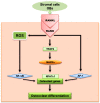Reactive Oxygen Species in Osteoclast Differentiation and Possible Pharmaceutical Targets of ROS-Mediated Osteoclast Diseases
- PMID: 31336616
- PMCID: PMC6678498
- DOI: 10.3390/ijms20143576
Reactive Oxygen Species in Osteoclast Differentiation and Possible Pharmaceutical Targets of ROS-Mediated Osteoclast Diseases
Abstract
Reactive oxygen species (ROS) and free radicals are essential for transmission of cell signals and other physiological functions. However, excessive amounts of ROS can cause cellular imbalance in reduction-oxidation reactions and disrupt normal biological functions, leading to oxidative stress, a condition known to be responsible for the development of several diseases. The biphasic role of ROS in cellular functions has been a target of pharmacological research. Osteoclasts are derived from hematopoietic progenitors in the bone and are essential for skeletal growth and remodeling, for the maintenance of bone architecture throughout lifespan, and for calcium metabolism during bone homeostasis. ROS, including superoxide ion (O2-) and hydrogen peroxide (H2O2), are important components that regulate the differentiation of osteoclasts. Under normal physiological conditions, ROS produced by osteoclasts stimulate and facilitate resorption of bone tissue. Thus, elucidating the effects of ROS during osteoclast differentiation is important when studying diseases associated with bone resorption such as osteoporosis. This review examines the effect of ROS on osteoclast differentiation and the efficacy of novel chemical compounds with therapeutic potential for osteoclast related diseases.
Keywords: osteoclast differentiation; osteoclasts; osteoporosis; reactive oxygen species.
Conflict of interest statement
The authors declare no conflict of interest.
Figures


References
Publication types
MeSH terms
Substances
Grants and funding
LinkOut - more resources
Full Text Sources

